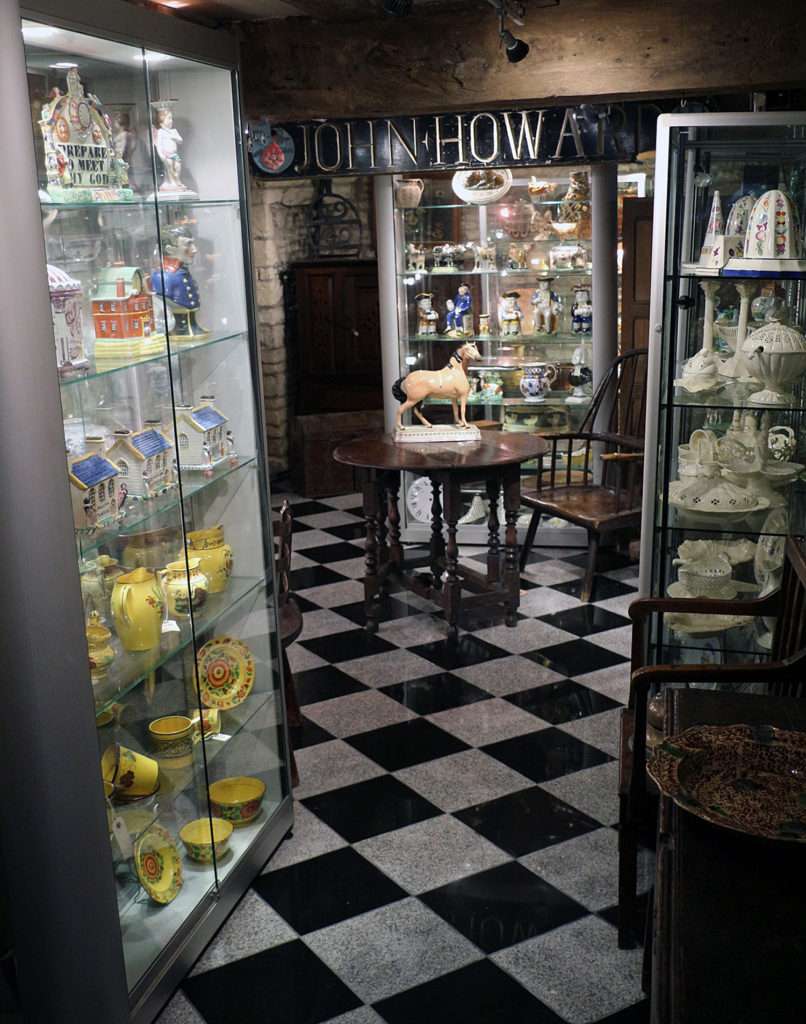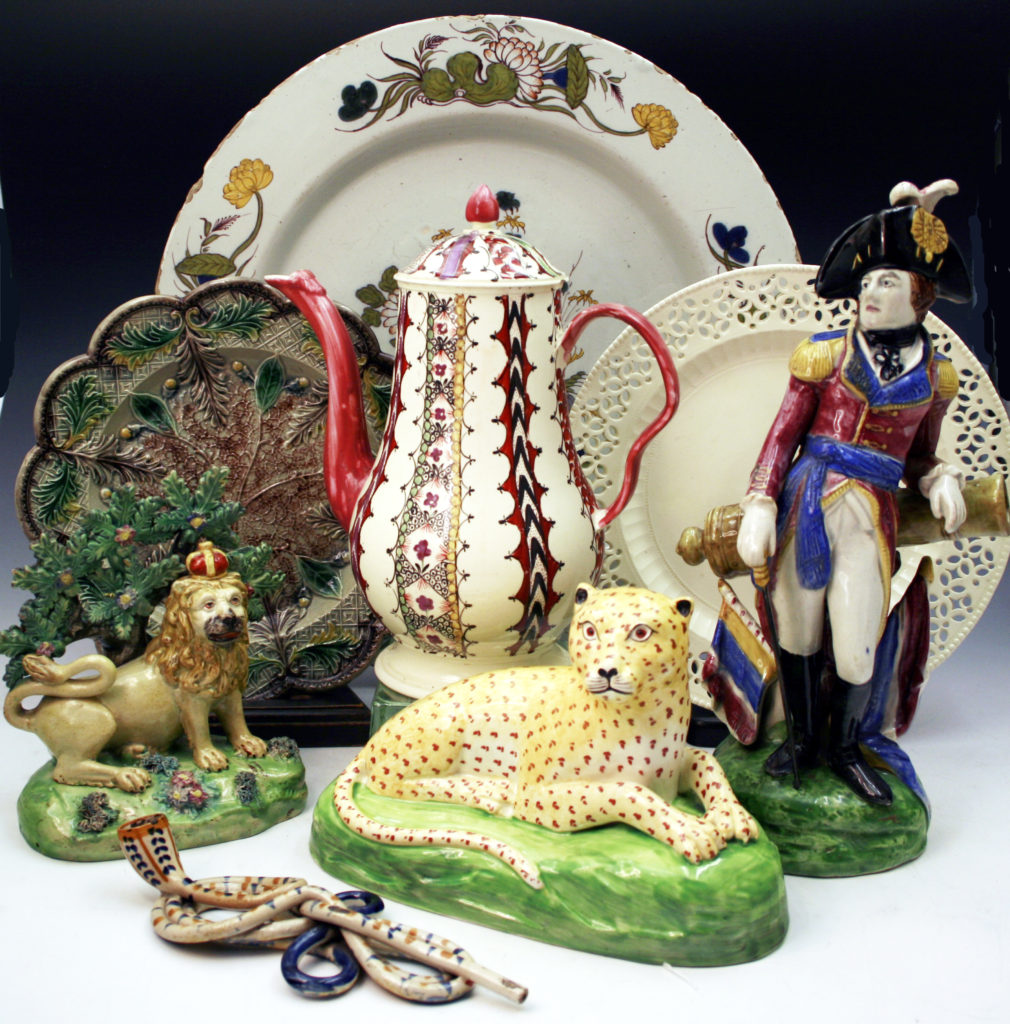Period Slipware is one of the most appealing subjects in the art of English pottery. The ware was developed in the 17th century and was made in London and many provincial areas in England and Wales. Mainly produced as utility kitchen domestic ware there are some pieces of complex and decorative form made for presentation. As is always the case with English pottery Staffordshire was perhaps the most prolific area of production. Slipware admired for its bold designs applied with a freedom of expression and imagination on organically satisfying earthenware finished with a lead glaze. Often described as a folk art tradition, this may be true, but today it is recognized that there is real artistry in the form which enables it to take its place in a traditional country setting or an ultra-modern dwelling. Read more…
The Cream of English Pottery
The story starts with the three founding fathers of English pottery, Thomas Whieldon, William Greatbatch, and Josiah Wedgwood. The triumvirate was instrumental in the development of ceramics in the mid 18th century, and it is Josiah who stands as the most significant, the brand name Wedgwood being known and respected over the globe to this day. Wedgwood is known mainly for his jasperware ranges but not universally acknowledged for his development of creamware, which revolutionized tableware in the 18th century, a legacy lasting to this day. Read more…
History in your hand
Iconic is an overused term, however, when relating to English Delftware, it appropriately defines the status of Blue Dash Chargers. The chargers were produced from around 1630 to 1720 and featured distinctive slanting dashes along the rim border. This distinctive ware produced by the London and Bristol potters usually boldly painted in a naïve abstract manner and intended as display pieces, which has enabled survival over three centuries. The subject matter was varied, religion, royalty, flowers, patriotic, are the prime themes. Read more…
What kind of wood is wedge?
One of the strangest questions asked of me was at the Ceramic Fair in New York on a snowy January morning many years ago. A visitor to the event was inspecting my display of early British pottery. After a few minutes, he came over to the counter looked me straight in the eye and assertedly said, “I have a question for you sir, what kind of wood is wedge”? I was a little perplexed for a moment as everything at the Fair was ceramic. Then it slowly dawned that he had been looking at my written label associated with a creamware Jelly Core which read ” WEDGWOOD. ” It is not very often I am rendered speechless, but I could only give him a spluttering reply about the master English potter Josiah Wedgwood. Read more…
Saving for a rainy day
I have three Welsh grandparents, but it was Grandma Evans I knew the most. It was because of her that my passion for old pots sparked as a young child. Grandad and Grandma Evans ran a small farm in what was then Cardiganshire, a county on the mid-west coast of Wales. I was fascinated by the old pitchers and blue and white plates on the dresser along with a pair of glass-eyed Staffordshire spaniels and a pair of cow spill vases. Read more…
A new look at herd immunity
I hope all is well with you and yours when you read this Newsletter. The international news is, of course, full of one thing, COVID19. This global pandemic has released a harsh impact, and no doubt has made us think about what matters in life, family, health, and home spring to mind amongst the many social, economic, and political factors. Read more…
One of the best kept secrets
Located in the small beautiful Cotswold town of Woodstock are many medieval period buildings, number 6 Market Place is the oldest domestic dwelling and was built in 1495. In the 16th century, the property was used as the Town Hall and interestingly was the residence of every Mayor of Woodstock until 1940. Today we have a group of 12 antique dealers trading under the name of “Antiques at Heritage” who operate from the ground floor. Read more…
The New Website
Well, at last, the migration from Online Galleries has been made by September 2019 deadline. It was quite a wrench when Online decided to end their hosting service and web support. I offered to adopt Joe (my main contact at Online), but my request was turned down by all parties! Joe and Carmine have been an important part of my team and I am very grateful to them for years of support. Fortunately, a web designer is located just across the road from my gallery in Woodstock, James at Oxfordshire Digital. He has re-designed the site with some improvements such as enabling large size images to be viewed, providing a magnifying lens and an overall cleaner design. The website has over 300 items for sale and an archive of over 2000 items. James has done a great job in building a new website and transferring all the information and images across. He may well live to regret the fact that I am based only 75 yards away from his front door, my PC skills are quite limited.

I am continually searching for the very best examples of early British pottery and am thankful that from over 40 years trading many pieces are offered to me from private collections. I no longer exhibit at antique fairs, so the website is an important feature of the business and works well with the gallery based in Woodstock. You will be made most welcome to visit in person, and I hope that the website continues to be a source of information and possibility for customers old and new.


